Wastewater treatment often involves different process steps and multiple technologies, depending for example on the origin of the wastewater. Read more about the role of magnesium hydroxide and magnesium chloride in wastewater treatment below.
pH neutralization
Magnesium hydroxide (Mg(OH)₂) is a suitable and cost-efficient alternative to caustic soda (NaOH) in pH neutralization of acidic wastewater streams. Due to more alkalinity compared to caustic soda, less product is needed for the same effect. This is because magnesium hydroxide contains two hydroxide ions per molecule instead of one like caustic soda. Due to this volume advantage and the price difference, the switch to magnesium hydroxide is worth considering. Read more about cost-efficient neutralization with magnesium hydroxide.
Phosphate removal and recovery
Stimulating a circular economy is an important topic at European level. The Netherlands also wants to achieve growth in a more sustainable manner. Part of a circular economy is the recovery of minerals from wastewater, including the finite mineral phosphate. The Dutch government is committed to ensuring that phosphate is fully recovered from wastewater streams by 2030. Phosphate recovery can be interesting if a wastewater stream contains a lot of phosphates, this is often the case at sewage treatment plants or industrial wastewater treatment of certain industries, such as potato processors.
Phosphate can be removed from wastewater in several ways. One of the ways to remove and recover phosphate is through controlled struvite formation. To capture phosphate as struvite, a magnesium salt is needed; magnesium chloride or magnesium hydroxide. The magnesium product binds to phosphate and converts it into magnesium ammonium phosphate, or struvite. The reaction takes place in a struvite reactor. By using struvite as a fertiliser, for example, the phosphate from wastewater can be reused. Therefore a so-called circular phosphate cycle can be realised.
Dewater sludge and remove metals
Many sewage treatment plants in the Netherlands use magnesium hydroxide to form struvite in a controlled manner. Because the pH does not get extremely high with magnesium hydroxide, the product is safe for microbiology in the biological purification step. Adding magnesium hydroxide has the added benefit of improved sludge dewatering and improved sludge quality.
Besides, magnesium hydroxide can be added to remove metals from waste streams by means of precipitation. Suitable metals for this purpose are copper, cadmium, chromium, nickel, cobalt, lead and zinc.
💧 Cost efficient
💧 Safe to use (non-corrosive)
💧 More alkalinity compared to caustic soda
💧 Slower reaction time and a buffer effect that keeps the pH more stable
💧 Safe for microbiology in biological purification
💧 Improved sludge dewatering
More information
Product knowledge, support from the lab/R&D and practical experience form the basis of our application knowledge. Technical support is available for customers that use our magnesium products in wastewater treatment.
For more information, read this article about recovering phosphorus to stimulate a circular economy.



